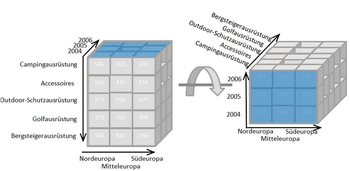Definition of Online Analytical Processing (OLAP) in The Network Encyclopedia.
What is Online Analytical Processing (OLAP)?
Online Analytical Processing, also known as OLAP, is a technology that allows users to perform sophisticated data analysis on typically large amounts of enterprise data to gain insight on the information it contains.

Examples of analysis include financial modeling, budget forecasting, production planning, and determining broad sales and distribution trends.
A query issued in online analytical processing (OLAP) system could be, “What would be the effect on sales over the next three quarters if the cost of widgets went up 5% while sales dropped 15%?” OLAP systems primarily focus on queries that ask “What if…?”
In other words, OLAP systems are designed for making predictions, modeling scenarios, and supporting decision-making.
The database for an OLAP system is structured to allow for efficient retrieval of information. The database can be a data warehouse. A data warehouse is a database that contains static data on a particular subject, drawn from various sources. Queries issued against data warehouses tend to focus on queries that ask “What was…?” or “Who did…?” and are useful for analyzing past sales and growth figures. For example, “What were the total sales for the five largest subsidiaries in the first two quarters of last year?” OLAP systems and data warehouses thus constitute two complementary tools for analyzing and interpreting business data in order to make smart decisions.
An OLAP system is typically based on a multidimensional model, which allows users to easily select, explore, and view the data. An OLAP system generally provides the technology for creating and managing the databases. An OLAP system can have tools to discover relationships between data items by comparing the results of various OLAP queries.
Microsoft SQL Server includes a number of tools for data warehousing and online analytical processing, including Data Transformation Services (DTS) Designer and SQL Server OLAP Services. You can use DTS Designer to specify the workflow steps and transactions for combining multiple heterogeneous data sources into a data warehouse. You can then use OLAP Services to analyze the data, pre-aggregate data into multidimensional cubes for frequently asked queries, model data, create new views, and perform ad hoc sets of calculations.